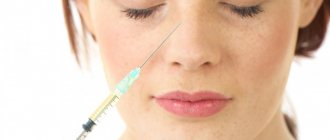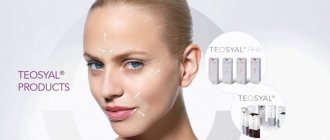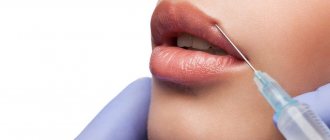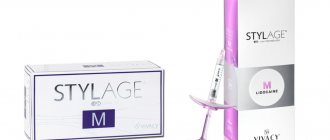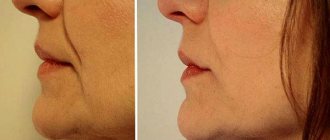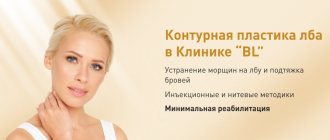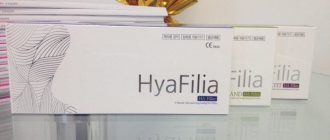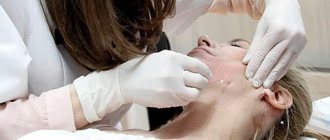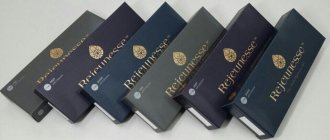The desire to maintain attractiveness and slow down the process of age-related changes is absolutely natural for every person. And the person in this matter is given special attention. It is this that first reveals the age of a person and especially a woman. Over the years, the skin inevitably loses its elasticity, the shape of the face deteriorates, wrinkles appear, natural folds deepen and other undesirable changes occur. In such situations, as well as in a number of others, in particular if you want to increase the volume of your lips, facial contour correction with fillers can help.
Fillers in cosmetology: what is it, photo
In the 1940-1950s, silicone was used as a filler for cosmetic procedures, but in many patients the body reacted to silicone as a foreign body, which led to the development of granulomas at the site of its injection. Therefore, it was soon banned. Since the 1970s, collagen injections have been actively used in cosmetology as fillers, and in 1995 the first fillers made from hyaluronic acid appeared. Today, 5 main types of fillers are used in cosmetology.
Fillers in facial cosmetology: types
- collagen-based fillers,
- fillers based on hyaluronic acid,
- based on poly-L-lactic acid,
- based on calcium hydroxyapatite,
- based on polymethyl methacrylate microspheres.
Currently, the most popular fillers are hyaluronic acid fillers. They are easy to use, effectively eliminate wrinkles and folds, and add additional volume. However, the duration of their effect (depending on the brand of the drug) is on average 6 months, and only some of them retain the effect for up to 12 months. In turn, with fillers made from poly-L-lactic acid or calcium hydroxyapatite, the effect lasts up to 18-24 months, but working with these drugs requires extensive experience and special training of the doctor.
And that is why such a filler as “Sculptra”, which is essentially a full-fledged replacement for plastic surgery, is practically not used in Russia (complex application techniques and the need for special training abroad). There is also a drug “Artefill” made from polymethyl methacrylate microspheres, the guaranteed effect after which lasts up to 10 years, but it is too expensive and is not used in Russia. Below you can read about the features of using all types of fillers and their comparative characteristics.
Fillers under the eyes, lips, fillers in the nasolabial area: before and after photos
How does the preparation and procedure go?
First of all, the doctor finds out if you have any contraindications. Discusses with you what needs to be adjusted, finds out your medical history. Be sure to tell us if you have already had touch-ups, undergone aggressive cosmetic procedures (such as laser resurfacing), or had plastic surgery.
Then the doctor selects the drug. Please note: the filler should only be opened in front of you!
Your face is cleaned of makeup, treated with antiseptic agents, then local anesthesia is applied - in the form of a cream or injection - to reduce discomfort.
Then the drug is injected in several stages into different points of the face and lips. As necessary, the doctor “helps” the filler to distribute evenly, gently pressing on the correction site.
Fillers: what kind of procedure is this, technique
Fillers are injected into the superficial, middle or deep layers of the skin using a syringe with a very thin needle (usually marked 27-30G). The depth of filler injection directly depends on the depth of wrinkles. The thinner the needle, the less painful the procedure will be and the lower the risk of hematomas after the procedure. However, only soft fillers intended for superficial wrinkles and the lip area can be injected using the finest needles.
To correct medium to deep wrinkles and folds, denser fillers are used that require a slightly larger needle diameter. Dense fillers dissolve more slowly than soft fillers, but their injection is more painful. Some fillers already contain the anesthetic lidocaine (usually 0.3%), or your doctor may administer a regional local anesthetic. The procedure usually takes from 15 to 30 minutes.
If we are talking about the correction of wrinkles, then fillers are injected into the base of each wrinkle using a syringe (Fig. 8). Thus, a filler depot is created under the wrinkle, which pushes the tissue outward, smoothing out the wrinkle or fold. If it is necessary to add additional volume to the cheeks or cheekbones, then the filler is injected into the skin evenly over the entire area.
Correction of deep wrinkles with filler –
The effect of most fillers is noticeable immediately after the procedure. Some fillers (those made with hyaluronic acid) are not fully hydrated with water. This means that after being introduced into the tissues, they will absorb a little water for another 24 hours, further expanding. Thus, you will see the final result only a day after administration. Whether the filler is fully hydrated or not is very important when you are choosing lip fillers.
The result of the injection of some fillers (such as Sculptra) appears only after 3-4 weeks, but this is one of the few drugs that works not due to the mechanical filling of tissues with gel, but due to the formation of new collagen. Radiess also has a similar effect, but the price for such fillers in cosmetology is always very high. You will find detailed information about them below.
What are fillers in facial cosmetology: video procedure
Lip massage after augmentation
It is strictly not recommended to massage your lips immediately after the procedure. This is fraught with infection. You must wait at least a day. It is better to slightly increase this period. However, in general, massage is beneficial. It will help the drug to be evenly distributed on the lips. As a result, the risk of unevenness will be significantly reduced. Additionally, this effect helps restore blood circulation. Overall, it will be possible to significantly shorten the healing period. It is better to massage after the swelling subsides. Until this moment, there is an active recovery period, and massage can cause harm.
Collagen based fillers –
Collagen is the main part of the dermal layer of the skin (dermis). The amount of collagen in the skin makes up 70% of its dry mass, and it is thanks to this protein that the skin has strength and elasticity. There are a total of 11 different types of collagen found in the skin, but the predominant types are collagen types I and III. Manufacturers use these same types of collagen to produce fillers, but their origin may be different. It can be bovine, porcine or bioengineered human collagen.
Collagen fillers have been used since 1981. The first fillers were made from bovine collagen (Zyderm 1, Zyderm 2 and Zyplast®). The production of modern collagen fillers uses the achievements of genetic engineering, or the innovative Israeli technology Glymatrix®, which allows you to start the process of formation of new collagen in tissues, and also extends the effect to 12 months. However, it should be noted that in Russia injections of collagen fillers are very rare (unlike Europe and the USA).
1) CosmoDerm® and CosmoPlast® fillers –
Fillers of this type include CosmoDerm 1, CosmoDerm 2 and CosmoPlast®. They are produced by the innovative American company Allergan Inc., which, by the way, is also the manufacturer of the drug Botox®. The production of these fillers uses bioengineered human collagen, which is obtained by culturing fibroblasts in vitro. Fibroblasts produce collagen, which is then used in the production of these fillers.
CosmoDerm 1 contains 35 mg/cm3 of bioengineered human collagen and a 0.3% lidocaine solution. This filler is most often used to treat superficial wrinkles and scars, such as wrinkles around the eyes or smoker's lines around the lips. In CosmoDerm 2, the amount of collagen will be 2 times greater, and this filler is more often used to eliminate post-acne scars. CosmoPlast also contains 35 mg/cm3 of collagen, but due to the use of glutaraldehyde, this drug undergoes slower breakdown than the first two.
Therefore, CosmoPlast is used to eliminate deeper wrinkles and atrophic scars, and very often often in combination with hyaluronic acid fillers. In this case, a voluminous tissue base is created using collagen filler, after which a more superficial injection of hyaluronic acid filler is performed into the same area. The advantages of CosmoDerm and CosmoPlast are that they do not require skin tests and produce less swelling and hemorrhage compared to hyaluronic acid injections. Disadvantages - high price, duration of action 3 and 4 months, respectively.
2) Evolence® fillers –
Evolence filler is the most innovative collagen-based filler that is just becoming widespread. Today it is used in Europe, Israel and the USA. , Israel. The drug contains porcine collagen types 1 and 3 in an amount of 35 mg/cm3. In the production of the drug, a number of cutting-edge technologies are used that make it possible to make pork collagen completely immunologically compatible with human collagen, but the most important thing is the Glymatrix® technology.
This technology makes it possible to bind collagen with the polysaccharide D-ribose, which gives collagen a certain three-dimensional structure, which is preserved even after the drug is introduced into the tissue. This three-dimensional framework is used by the patient's skin fibroblasts to produce their own collagen, triggering the processes of neocollagenogenesis and neovascularization. At the same time, the activity of fibroblasts in the skin, producing new collagen, increases noticeably.
There are 2 forms of release of this filler - Evolence® and Evolence® Breeze. The first is used to correct deep wrinkles and folds on the face, and can be applied to the middle and deep layers of the skin. The second has a less fibrous consistency and is used to eliminate fine wrinkles, to change the contour of the red border of the lips, as well as the shape of the body of the lips. Clinical studies conducted by Rzany, Monstrey and co-authors (involving a total of 740 people) showed that the effect after Evolence lasted at least 12 months, and in some patients lasted up to 18 months.
Evolence® filler injections –
Contraindications
- oncology (consultation with an oncologist is required);
- endocrine disorders (consultation with an endocrinologist is needed);
- diabetes;
- pregnancy, breastfeeding;
- bleeding disorders;
- taking blood thinning medications;
- exacerbation of chronic diseases;
- increased body temperature;
- herpes;
- cold;
- mental disorders;
- violation of the integrity of the skin;
- skin diseases;
- vascular pathologies;
- heart diseases.
Fillers based on hyaluronic acid –
Hyaluronic acid fillers are most often used to eliminate cosmetic defects. They are easy to use and do not require too much training from a doctor. Hyaluronic acid is a polysaccharide that is constantly synthesized by skin cells. Its biological role is to moisturize the skin and give volume to the skin, which becomes possible due to the fact that its molecules are able to hold a volume of water - 1000 times greater than the volume of the molecules of the polysaccharide itself.
The “lifetime” of hyaluronic acid molecules in the body is no more than 24-48 hours, which is why so-called “bound hyaluronic acid” is used for the production of fillers. It is a gel in which single molecules of hyaluronic acid are linked to each other (using special substances) in long chains, which prevents its rapid destruction. After being introduced into the tissue, such a gel retains its elastic structure and volume for a long time, which makes it possible to use it to correct wrinkles and add volume to facial tissues. The duration of the effect is usually about 6 months, but for some drugs the effect lasts up to 9-12 months.
Type of hyaluronic acid filler –
Below we list the most popular hyaluronic acid fillers, but in general there are a very large number of them, and they all have different properties. For example, one of the most important characteristics of a filler is its elasticity (density). High-density fillers are used to eliminate deep wrinkles and folds. Slightly less dense ones are intended to create volume in the cheekbones and cheeks, and very soft ones are used in the lips and eyes. In Table 1 you will find information about filler brands and for which areas of the face they are recommended.
1) Restylane® filler (Restylane) –
Restylane contains non-animal hyaluronic acid obtained through bacterial fermentation. The manufacturer is Q-Med (Sweden). This is the most popular filler in the United States (approved by the FDA in 2003). It has a high concentration of hyaluronic acid - 20 mg per 1 ml. Restylane refers to incompletely hydrated gels, i.e. During the first 24 hours after injection, it will absorb moisture, which will lead to additional expansion of the soft tissue at the injection site.
Due to the fact that the gel has medium density and elasticity (gel viscosity corresponds to 100,000 particles per 1 ml), it is well suited for the correction of wrinkles of medium depth. The effect after its administration lasts from 6, but not more than 8 months. This drug is ideal for reducing the depth of nasolabial folds, marionette lines at the corners of the mouth, nasal defects, acne scars, as well as for lifting the tip of the nose.
In addition to the classic Restylane® filler, there are also several options that are more adapted to specific tasks: 1) “Restylane Touch” - for eliminating the smallest wrinkles, 2) “Restylane Lip” - for correcting lip volume, 3) “Restylane Sub-Q” - to create additional volume in the cheekbones and cheeks. All these preparations contain the same concentration of hyaluronic acid, and differ only in the density/elasticity of the gel. The cost of 1 syringe with a volume of 1 ml for clinics is from 6,000 rubles, which in our opinion makes this filler the best in terms of price/quality ratio. In clinics the price starts from 10,000 rubles.
A big plus of Restylane brand fillers is that the manufacturing company tests its fillers for residual content of bacterial proteins. This is important because Almost all fillers are now produced by bacterial fermentation, and residual proteins can cause the risk of allergic reactions. For example, the popular Juvederm fillers do not undergo such laboratory tests. However, there are no comparative data in the literature on the frequency of allergic reactions of different brands of fillers.
→ Restylane® filler release forms
2) Perlane® filler (Perline) –
Perlane filler was also developed by Q-Med (Sweden). It is part of the Restylane® line of fillers, differing from them in higher viscosity and gel density. At the same time, the concentration of hyaluronic acid in it is the same - 20 mg per 1 ml. This filler is FDA approved and is designed to treat only severe deep wrinkles and folds of the skin. The duration of the effect is about 9 months after the injection (sometimes longer).
This gel is an excellent option for reducing the severity of nasolabial folds, increasing the volume of the cheekbones, reducing deep wrinkles on the chin, and marionette lines in the corners of the mouth. In general, to successfully work with this drug, the doctor must have extensive experience in using fillers, because Perlane has a very high density. Using such a gel with insufficient experience can lead to the skin surface being uneven (lumpy). The cost of 1 syringe with a volume of 1 ml is about 7,000 rubles, and in clinics the cost usually starts from 12,000 rubles.
3) Juvederm® filler (Yuvederm) –
Juvederm is one of the most popular fillers in Europe and the USA. Manufacturer: Allergan Inc. (USA). Contains hyaluronic acid obtained using bacterial fermentation technology. The gel is not fully hydrated, so additional expansion should be expected in the first 24 hours after injection. Two forms of Juvederm® filler were approved by the FDA in 2006: Juvederm Ultra and Juvederm Ultra Plus. They correspond to those released for Russia - “Juviderm Ultra 3” and “Juviderm Ultra 4”.
In Juvederm Ultra 3 and Juvederm Ultra 4, the concentration of hyaluronic acid is the same - 24 mg / 1 ml, but they differ from each other in the density of the gel. Juvederm Ultra 4 gel is the densest and is used to correct deep wrinkles and folds, as well as atrophic scars. The slightly less dense Juvederm Ultra 3 is used to correct wrinkles of medium depth, but it is also suitable for working with the contour of the red border of the lips. Moreover, both of these gels are equally suitable for increasing the volume of the cheekbones, reducing the depth of nasolabial folds, as well as for marionette wrinkles.
The cost of 1 syringe with a volume of 1 ml (depending on the form of release) ranges from 7,000 to 13,000 rubles, and accordingly in clinics the price will start from 12,000 rubles for the most inexpensive option - Juvederm Ultra 2, used for lips and wrinkles around the eyes . The duration of the effect of Juvederm Ultra 3 is similar to Restylane® filler and is 6-9 months, but the effect of Juvederm Ultra 4 will last up to 12 months. Additionally, there are 5 more variants of this filler, designed for narrow areas of application (you can check them out at the link below). These include -
- Juvederm Ultra 2,
- Juvederm Voluma,
- Juvederm Ultra Smile,
- Juvederm Volbella (Volbella),
- Juvederm Volift (Volift).
→ Juvederm® filler release forms
4) Filler Belotero (Belotero) –
Belotero filler was created by the Swiss company Anteis SA, but currently the owner of the brand is the pharmaceutical company Merz (Germany). Belotero is positioned as a “smart filler” that has a unique degree of homogeneity and the ability to be evenly distributed in tissues. This will ensure that you don't feel it on your skin. Has FDA approval. The line of this filler is represented by 3 drugs - Belotero Soft, Belotero Balance and Belotero Intense.
Belotero Soft – contains 20 mg/ml3 of hyaluronic acid, and is intended for the correction of fine superficial wrinkles, as well as delicate areas of the face, neck and décolleté with thin skin. Belotero Balance – contains 22.5 mg/ml3 hyaluronic acid, and is used to correct medium-sized wrinkles and folds, as well as lip augmentation. And the third option - Belotero Intens - with 22.5 mg/ml3 of hyaluronic acid, for the correction of deep wrinkles and folds, as well as increasing the volume of the cheekbones and cheeks. The effect lasts approximately 6-9 months. The cost of 1 syringe with a volume of 1 ml is about 6,000 rubles.
→ Cost in clinics – from 11,000 rubles per 1 ml.
5) Filler Stylage –
Stylage® filler is produced by the French company VIVACY Laboratories. Stylage filler has a whole line of drugs. First up is a line of 3 Stylage® fillers - lettered S, M and L. They target fine superficial, medium and deep wrinkles, respectively. The effect of Stylage® S lasts up to 9 months, and M and L - up to 12 months. Each gel version is available with or without lidocaine.
The second option is a soft filler called Stylage Lips, which contains 18.5 mg/ml3 of hyaluronic acid and is intended only to increase the volume of the body of the lips and/or contour their red border. The effect lasts about 6 months, sometimes longer. Well, the third option is Stylage XL and XXL fillers, which are designed to add volume to the cheekbones and cheeks. The effect lasts about 12 months (24stoma.ru).
The manufacturer, as one of its competitive advantages, claims to contain antioxidants (mannitol and sorbitol), which slow down the destruction of the hyaluronic acid gel. However, the process of destruction of hyaluronic acid gels in tissues depends on many factors, and antioxidants are not the main ones. The manufacturer does not publish comparative studies on this issue with other fillers. The cost of Stylage® S,M,L is about 3500-4000 rubles (for 1 syringe). The cost of other forms is about 5,500 rubles per 1.0 ml syringe. In proportion to this, you can calculate the price in clinics (usually + 5,000 rubles to the cost of the drug).
6) Princess® and Hyalax® fillers –
Both Princess filler and Gialax filler are produced by the same company Croma-Pharma (Austria). There are 2 release forms in the Princess line of fillers. The first option is the classic Princess Filler®, this is a fairly soft filler that can be used for superficial and medium wrinkles, as well as for lip augmentation. To correct deep wrinkles and nasolabial folds, increase the volume of the cheekbones and cheeks, you can use a denser version of this drug - Princess Volume.
The effect of classic Princess filler will last 4-6 months. The effect of the second filler option will last up to 6-9 months. It must be said that this brand is the most inexpensive among fillers. Cosmetology clinics buy them - only 3,000 and 3,500 rubles, respectively (for a 1.0 ml syringe), and the low price allows for a higher markup. For comparison, the purchase cost of 1 1.0 ml syringe of Juvederm Ultra 3 is about 11,000 rubles.
It should be noted that for Princess fillers (in comparison with those listed above), very few clinical studies have been published, and with not too many people who took part in them. However, if you want to save money or get acquainted with the contouring procedure for the first time, you may well choose this particular brand. By the way, another economical option is the “Revofil” line of fillers (Fine, Plus and Ultra), made in Korea. Their purchase price for a 1.0 ml syringe is also only about 3,100 rubles.
How many sessions are required?
Usually one procedure is enough to achieve the desired result. However, each body is individual, each perceives fillers in its own way. If you are performing correction for the first time and, for example, want to significantly increase the volume of your lips, then it is likely that you will not be able to achieve the desired effect the first time: the drug will change its shape and make your lips more moisturized, but you will have to add volume.
For most patients, one procedure is enough. In any case, this is determined solely by the doctor, who consults you before the injection, performs contouring with fillers, and then invites you for an examination some time after completion of rehabilitation to evaluate the effect and distribution of the drug.
The effect lasts for at least six months. For some, the results of facial correction using injection methods are visible for up to 1.5 years. Here, too, everything is individual and depends largely on your metabolism or lifestyle. If you are young, play sports and lead an active lifestyle, most likely the drug will be absorbed and eliminated from the body faster than in an older person who leads a calm and measured life.
However, there is good news: contouring can be performed repeatedly, adjusting the face as the need arises.
Radiesse filler (based on calcium hydroxyapatite) –
The most popular filler of this type is Radiesse. The drug was developed by a well-known American biotechnological company, but at the moment the drug belongs to the German company. Has FDA approval. The drug consists of microspherical particles (25-45 microns in size) of 30% calcium hydroxyapatite, which are suspended in a gel-like carrier.
The gel-like filler carrier dissolves approximately 2-3 months after injection, after which the skin cells come into direct contact with the microspheres. Clinical studies have shown that the gradual destruction of microspheres by macrophages leads to the activation of fibroblast function and the replacement of this volume with newly formed collagen (according to Hirsch R. and Cohen J.). Thus, Radiesse filler is one of the few drugs that actually stimulates neocollagenogenesis. At the same time, calcium and phosphate ions formed during the destruction of microspheres do not have antigenic properties, i.e. the drug is completely immunologically inert.
Another very interesting point is that the body sometimes responds to the introduction of any type of filler by forming granulomas in the soft tissues, perceiving them as a foreign object, which is a common complication when using dermal fillers. An interesting point is that after injection of Radiesse, granulomas never form. Indications for use of Radiesse: correction of nasolabial folds, cheekbones, hollow cheeks, marionette lines. The average duration of the effect is from 9 to 18 months, and unlike the drug Sculptra (see below), the wrinkle smoothing effect will be visible immediately after the procedure.
→ The price for Radiesse in clinics is from 16,000 rubles for 0.8 ml, and from 25,000 rubles for 1.5 ml.
Rehabilitation
After the procedure, the doctor will definitely tell you exactly how to care for your face in the coming days to ensure the best result. Follow his advice, take the prescribed medications and treat the correction area as the doctor said. However, there are recommendations that are common to everyone:
- Do not touch or knead the injection site unless your doctor tells you to do so. The drug will distribute itself, massage may cause damage;
- Don't sleep with your face on the pillow. Try to rest while lying on your back;
- Do not touch your face with dirty hands - first wash them or treat them with antiseptic gel;
- For two days, do not use decorative cosmetics and aggressive makeup removers;
- If you had lip contouring, avoid kissing and do not eat too hot food or drinks for a couple of days after the procedure. Alcohol is also prohibited - for about 5-7 days;
- Limit physical activity for 14 days. The sport will wait, let the filler calmly spread over the face;
- Avoid hot baths and saunas for a couple of weeks after the injection;
- For a month after the procedure, you should not overuse your time on the beach or visit the solarium. And if you did the correction in the summer, be sure to use a high SPF cream before leaving the house.
Sculptra filler (poly-L-lactic acid based) –
Sculptra filler is a synthetic, biologically compatible, immunologically inert polypeptide that consists of microspherical particles of poly-L-lactic acid. Many experts call this filler a dermal stimulator, because... it is not a traditional dermal filler - unlike traditional hyaluronic acid or collagen fillers. Its mechanism of action is to initiate the formation of new collagen in the dermis, resulting in a slow correction of deep wrinkles and restoration of soft tissue volume.
The drug is produced by the international dermatological company Galderma®.
The mechanism of action of the drug is such that when administered correctly, it not only corrects the depth of the wrinkle, but also restores the volume of lost collagen in the injection area. In essence, this is more like the injection of fatty tissue when correcting sunken areas of the face and deep folds, which arise as a result of a decrease in the volume of deeper structures (dermis and subcutaneous fatty tissue). Small and precise volumes of Sculptra should be injected into the correction area to avoid overcorrection. In patients 30-39 years old, 2-3 cm3 of the drug is usually used, in 40-49 years old - 4 cm3, in older patients - 5 cm3.
The cosmetic effect after administration does not appear immediately, but not earlier than after 4 weeks. Sculptra injections are performed monthly (or rather, at intervals of 4-6 weeks) until the patient is satisfied with the amount of correction of the problem area. Therefore, it is impossible to immediately say exactly how much of the drug you will need, but usually this is 3-4 courses of injections. The best effect is achieved in pre- and postmenopausal women receiving hormone replacement therapy. A worse effect occurs in postmenopausal women NOT receiving hormone replacement therapy. Studies have shown that cosmetic defects in men are corrected more quickly when using Sculptra than in women (for an unknown reason).
If it is important for the patient to immediately achieve a cosmetic effect, then Sculptra can be combined with other fillers (and already during the first visit), but Sculptra must be injected first. It is successfully used to increase the volume of cheekbones, cheeks, and correct nasolabial folds, and the achieved results last for at least 18-24 months. Very important: the technique of working with this drug is very complex, and the doctor must undergo special training, which is provided by the manufacturer of this drug (you must ask the doctor to present such a certificate). But the effect of this drug will be the most impressive, like after a successful plastic surgery.
→ Sculptra price – from 20-30 thousand rubles for 5.0 ml.
Indications
- Presence of age-related changes and/or wrinkles, furrows;
- “Floated”, asymmetrical oval face;
- Wrinkles in the eyelid area and corners of the eyes;
- Nasolabial folds of different depths;
- Changing the shape of the nose, restoring the volume of the cheekbones and chin;
- Elimination of asymmetry, changing the shape/volume of lips;
- Decreased skin tone, enlarged pores;
- Skin defects (atrophic scars, including stretch marks, post-acne);
- Various types of atrophy of facial and body tissues.
Facial fillers: SUMMARY
We hope that it is now clear to you what facial fillers are, and for your convenience, we will group them below by specific areas of application. Many of them are approved by the FDA (US Federal Bureau of Drug Control). Despite the fact that FDA recommendations are always a guarantee of safety and effectiveness, in some cases the lack of recommendations does not indicate poor quality of the drug, but bureaucratization and slow decision-making. Most often, the FDA gives its approval only 10-15 years after the appearance of a new drug (even despite the presence of a sufficient volume of clinical trials).
Lip fillers –
A very important point for choosing lip filler is that to increase the volume of the lip body and to create a clearer contour of the red border of the lips (in the form of a “Snow White line” or “Cupid’s bow”), the use of different filler options may not be optimal. To create the contours of the red border, slightly denser fillers can be used than to add volume to the body of the lips. In Table 1 below you will find a list of drugs that are suitable for these purposes.
It is very important not to use fillers that are too dense (such as Juvederm Ultra 3 or 4) for lip augmentation, despite the fact that the duration of their effect will be longer. This is due to the fact that the lips may lose their natural elasticity, and patients may also feel denser inclusions inside the lip body.
Cheek fillers recommended by the FDA -
Fillers for cheekbones or to increase cheek volume should have average density and elasticity. Fillers that are too soft are completely unsuitable for this area, and fillers that are too dense will feel like a foreign body. To correct cheekbones, the FDA recommends using fillers - Juvederm, Radiesse, Sculptra, etc. Some products, although not FDA recommended (such as Restylane Sub-Q or Juvederm Volume), have been created specifically for this area of the face. They hold volume well, and the result can be noticeable for up to 2 years.
FDA Recommended Nasolabial Fold Fillers –
Fillers in the nasolabial folds (patients often call them nasolabial fillers) should also have a medium or high gel density, as well as low elasticity. For these purposes, the FDA has approved a large number of drugs - Restylane, Juvederm, Belotero, Sculptra, Radiesse, ArteFill and others. We list specific filler options from different brands in Table 1 below.
Despite the apparent simplicity of using fillers in nasolabial folds, reviews will depend not only on the correctly chosen brand of the drug, but also on the treatment strategy. If the patient has pronounced nasolabial folds, the doctor can choose between two treatment strategies: firstly, you can correct the nasal folds themselves, and secondly, introduce a filler in the area of the cheekbones and cheeks, which will pull the skin back and smooth out the folds .
When treating patients with large, round cheeks, it is preferable to choose correction of the nasolabial folds themselves. And when treating patients with sunken cheeks and a small amount of tissue in the cheekbone area, it is better to introduce filler in the area of the cheeks and cheekbones (in such patients this will achieve a better aesthetic result).
FDA Recommended Under Eye Fillers –
No filler is yet FDA approved for use in the eye area. However, this does not mean that the fillers used under the eyes are dangerous and reviews from cosmetologists and patients strongly confirm this. As we said above, the lack of FDA recommendations does not mean that the drug does not have enough clinical studies or has bad reviews. For the area around the eyes, much softer fillers are used than for the nasolabial folds, cheekbones or cheeks (for example, Juvederm Ultra 2 or Restylane Touch).
Table No. 1 (according to the recommendations of Baumann L.) –
* In addition to hyaluronic acid-based fillers, the table also lists collagen-based fillers (CosmoDerm, CosmoPlast and Evolence), which we also discussed at the beginning of the article. We hope that our article: Fillers in cosmetology - what are they, photos, reviews - was useful to you!
Sources:
1.
, 2. Personal experience with fillers, 3. National Library of Medicine (USA), 4. https://aestheticsjournal.com, 5. https://www.nlm.nih.gov/ (NCBI, USA),6. “Cosmetic dermatology” (L. Bauman), 7. “Injection methods in cosmetology” (B. Asher).
Lip care after augmentation
You need to take good care of your lips. This will speed up healing and also minimize the risk of negative consequences. Care includes the following activities:
- Using moisturizing balms or hygienic lipsticks. They will saturate the area with liquid and prevent cracking.
- Minimizing physical activity. It is better not to go to the gym for about 2 weeks. Visiting him is fraught with increased blood pressure, which is extremely undesirable.
- To relieve swelling, it is recommended to use special ointments. The doctor will prescribe them.
- If inflammation or herpes appears, you must inform a specialist. He will examine the area and then suggest treatment.
In general, the healing process proceeds quite quickly. The injected gel will saturate the skin with hyaluronate, and the area will take the required shape. To quickly relieve swelling and redness, you can apply a cold compress. It is not recommended to perform them too often. Extreme cooling can lead to dryness, resulting in a risk of chapped lips. This is fraught with the appearance of new wounds and an increase in healing time.
